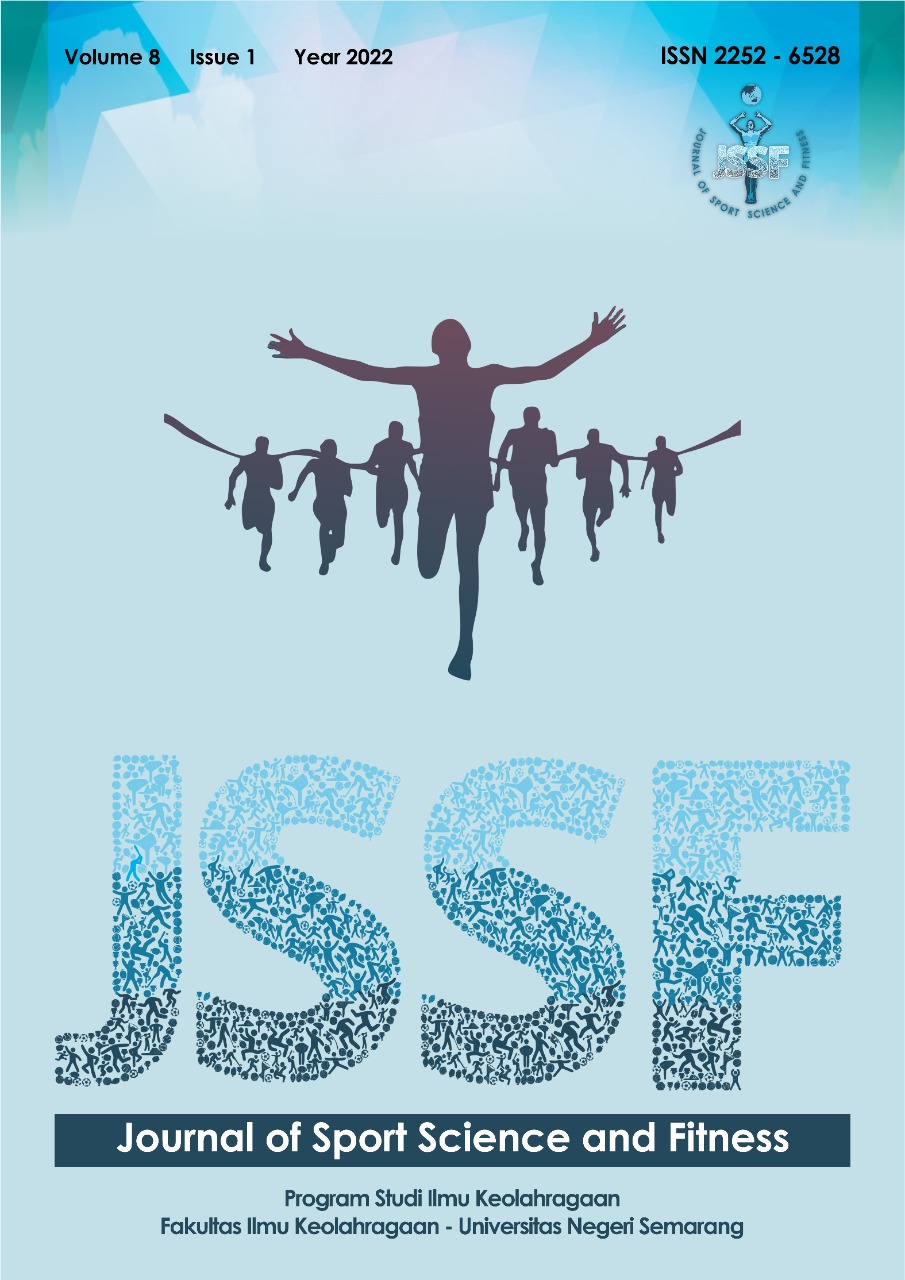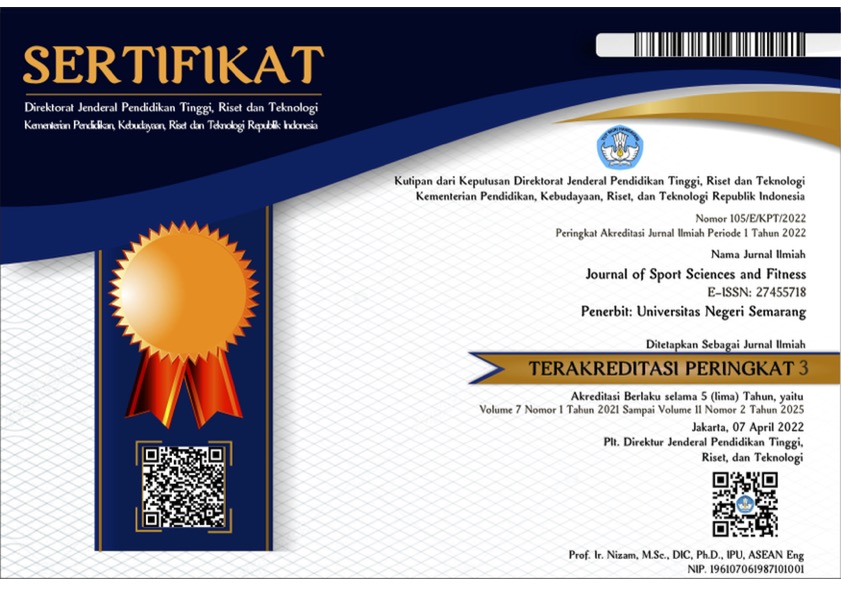HUBUNGAN KECUKUPAN GIZI DAN AKTIVITAS FISIK TERHADAP AGE OF PEAK HEIGHT VELOCITY PADA ANAK
Abstract
Abstrak
Tujuan penelitian ini adalah untuk mengetahui hubungan antara kecukupan gizi dan aktivitas fisik terhadap Age of PHV pada anak usia 9-14 tahun. Metode yang digunakan dalam penelitian ini adalah survei tes dengan teknik pengumpulan data menggunakan kuesioner dan tes pengukuran. Populasi pada peneiltian ini yaitu atlet SSB Tugumuda dan siswa kelas 4 di SDN Karangjati 04. Sampel yang diambil sebanyak 29 anak laki-laki dari SSB Tugumuda dan 23 anak laki-laki dari SDN Karangjati 04 yang berusia 9-14 tahun . Teknik pengambilan sampel menggunakan purposive sampling. Teknik analisis data pada penelitian ini menggunakan uji korelasi bivariat pearson. Hasil penelitian menunjukkan bahwa, 1) Angka kecukupan gizi dikategorikan “kurang”, sebanyak 52 responden (100%) tidak ada yang melampaui angka kecukupan gizi (AKG) dengan rincian 300 gr/hari karbohidrat, 50 gr/hari protein perhari, 1,2 gr/hari kalsium, 2) Tingkat aktivitas fisiksebanyak 1 anak (1,9%) memiliki tingkat aktivitas yang “rendah”, sebanyak 18 anak (34,6%) aktivitias fisiknya dikatakan “cukup”, 32 anak (61.5%) dengan tingkat aktivitas fisik “tinggi” dan 1 anak (1,9%) memiliki tingkat aktivitas yang “sangat tinggi”, 3) Rata-rata Age of PHV adalah 14,02 tahun. Disimpulkan bahwa terdapat hubungan antara kecukupan gizi dan aktivitas fisik terhadap Age of PHV pada 2 kelompok.
Abstract
The purpose of this study was to determine the relationship between nutritional adequacy and physical activity on the Age of PHV in children aged 9-14 years. The method used in this research is a test survey with data collection techniques using questionnaires and measurement tests. The population in this study were athletes from SSB Tugumuda and grade 4 students at SDN Karangjati 04. The samples were 29 boys from SSB Tugumuda and 23 boys from SDN Karangjati 04 aged 9-14 years. The sampling technique used was purposive sampling. The data analysis technique in this study used the Pearson bivariate correlation test. The results showed that, 1) The nutritional adequacy rate was categorized as "less", as many as 52 respondents (100%) none of which exceeded the nutritional adequacy rate (RDA) with details of 300 g/day carbohydrates, 50 g/day protein per day, 1.2 g/day calcium, 2) Physical activity level of 1 child (1.9%) had a "low" activity level, 18 children (34.6%) had "enough" physical activity, 32 children (61.5%) with physical activity level was “high” and 1 child (1.9%) had activity level “very high”, 3) The average Age of PHV was 14.02 years. It was concluded that there was a relationship between nutritional adequacy and physical activity on the Age of PHV in the 2 groups.
References
Afriani, Y., Sari, S. P., Puspaningtyas, D. E., Kesehatan, F. I., & Yogyakarta, U. R. (2019). Penyusunan Menu Gizi Seimbang Bagi Orang Tua Atlet Sepak Bola Di SSB Real Madrid UNY Dan SSB Baturetno. 80–86.
Arikunto, dan S. (2009). Manajemen Penelitian (W. Anjaryani (ed.)). Rineka Cipta.
Azizin, I. (2014). Hubungan Status Gizi Dan Aktivitas Fisik Siswa Sekolah Dasar. Jurnal Kesehatan Olahraga.
Balyi, I., & Way, R. (2009). The Role of Monitoring Growth in Long-Term Athlete Development Canadian Sport for Life.
Batubara, J. R. (2016). Adolescent Development (Perkembangan Remaja). Sari Pediatri, 12(1), 21.
Bungin, B. (2013). Metodologi Penelitian Kuantitatif. Kencana Prenada Media Group.
Cardinal, C. (2007). How to Measure Peak Height Velocity (PHV)? Synchro Canada, January, 1–2.
Casey, B. J., Tottenham, N., Liston, C., & Durston, S. (2005). Imaging the developing brain: What have we learned about cognitive development? Trends in Cognitive Sciences, 9(3 SPEC. ISS.), 104–110.
Catley, M. J., & Tomkinson, G. R. (2013). Normative health-related fi tness values for children : analysis of 85347 test results on 9 – 17-year-old Australians since 1985. 98–109.
Chairunnisa, E. (2017). Inadekuat Kecukupan Vitamin D , Kalsium Dan Fosfor Pada Anak Stunting Usia 12-24 Bulan Program Studi Ilmu Gizi.
De Oliveira, M. V. M., Pérez, J. R. O., Alves, E. L., Martins, A. R. V., & De Paula Lana, R. (2002). 2000 CDC Growth Charts for the United States: Methods and Development. In Revista Brasileira de Zootecnia (Vol. 31, Issue 3 SUPPL).
Djoko Pekik, I. (2007). Panduan Gizi Lengkap Keluarga dan Olahragawan. 45–46.
Faigenbaum, Avery D, Kraemer, Wiliam J, Blimkie, Cameron J, Jeffreys I, Micheli, Lylie J, Nitka, M, and R. T. (2009). Risks and Concerns Related to Youth Resistance Training. 60–79.
Gibson, R. S., Manger, M. S., Krittaphol, W., Pongcharoen, T., Gowachirapant, S., Bailey, K. B., & Winichagoon, P. (2007). Does zinc deficiency play a role in stunting among primary school children in NE Thailand ? 167–175.
Handayani, R., Irwanto, I., Purwanti, D., & Fatmaningrum, W. (2017). Usia Pubertas Dan Menarche Terhadap Tinggi Badan Mahasiswa Kebidanan. Media Kesehatan Masyarakat Indonesia, 13(1), 21.
Harahap, H., Sadjaja, & Soekarti, M. (2015). Kepadatan Tulang, Aktivitas Fisik Dan Konsumsi Makanan Berhubungan Dengan Kejadian Stuntung Pada Anak Usia 6 - 12 Tahun. 38(1), 1–8.
Hobold, E., Jupir, L., Flores, F., Brandt, R., Junior, O. M., & Arruda, M. De. (2017). Peak height velocity in anthropometry and body composition of students. June, 309–315.
Kowalski, K., Crocker, P., & Donen, R. (2005). Paq-C & Paq-a. College of Kinesiology, University of Saskatchewan, 87(August), 1–38.
Lloyd, R. S., & Oliver, J. L. (2012). The youth physical development model: A new approach to long-term athletic development. Strength and Conditioning Journal, 34(3), 61–72.
Lloyd, R. S., Oliver, J. L., Meyers, R. W., Moody, J. A., & Stone, M. H. (2012). Long-term athletic development and its application to youth weightlifting. Strength and Conditioning Journal, 34(4), 55–66.
Lloyd, R. S., Radnor, J. M., Moeskops, S., Meyers, R. W., Read, P. J., & Oliver, J. L. (2019). Applying Strength and Conditioning Practices to Young Athletes. Routledge Handbook of Strength and Conditioning, 23–37.
Mauluddin, M. I. (2019). Identifikasi Maturasi Fisik Anak Usia 10-14 Tahun Dengan Metode Mirwald Gender-Specific Regression Algorithms Pada Atlet Putra Klub Renang Di Surabaya. Jurnal Kesehatan Olahraga, 7(2), 239–244.
Mirwald, R. L., Baxter-Jones, A. D. G., Bailey, D. A., & Beunen, G. P. (2002). An assessment of maturity from anthropometric measurements. Medicine and Science in Sports and Exercise, 34(4), 689–694.
Olszewski, R. (2007). Long Term Athlete Development - Finally. Athletics, 16–17.
Philippaerts, R. M., Vaeyens, R., Janssens, M., Van Renterghem, B., Matthys, D., Craen, R., Bourgois, J., Vrijens, J., Beunen, G., & Malina, R. M. (2006). The relationship between peak height velocity and physical performance in youth soccer players. Journal of Sports Sciences, 24(3), 221–230.
Philippaerts, R., Vaeyens, R., Janssens, M., Renterghem, bart van, Mathys, D., Craen, R., Bourgois, J., Vrijens, J., Beunen, G., Robert, & Malina. (2006). Peak high velocity2006 RO.pdf. In Journal Sport Sciences (Vol. 24, Issue 3, pp. 221–230).
Rogol, A. D., Clark, P. A., & Roemmich, J. N. (2000). Growth and pubertal development in children and adolescents: Effects of diet and physical activity. American Journal of Clinical Nutrition, 72(2 SUPPL.).
Sciences, R., & Leuven, U. (2005). Prediction of adult height using maturity-based cumulative height velocity curves.
Sowell, E. R., Thompson, P. M., Tessner, K. D., & Toga, A. W. (2001). Mapping continued brain growth and gray matter density reduction in dorsal frontal cortex: Inverse relationships during postadolescent brain maturation. Journal of Neuroscience, 21(22), 8819–8829.
Van Der Sluis, A., Elferink-Gemser, M. T., Brink, M. S., & Visscher, C. (2015). Importance of peak height velocity timing in terms of injuries in talented soccer players. International Journal of Sports Medicine, 36(4), 327–332.
Viru, A., Loko, J., Harro, M., Volver, A., Laaneots, L., & Viru, M. (1999). Critical Periods in the Development of Performance Capacity during Childhood and Adolescence. In European Journal of Physical Education (Vol. 4, Issue 1).
Walker, O. (2016). Peak Height Velocity. Science for Sports.








